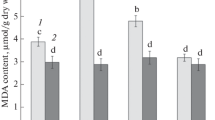Summary
Potato (Solanum tuberosum L.) cultivars differed markedly in their susceptibility to autolysis during the post-wounding period. Slices from cultivars susceptible to autolysis showed higher respiration rates than those sampled from resistant cultivars. The higher oxygen consumption of these cultivars was inhibited by imidazole. Application of the respiration inhibitors, KCN and SHAM, to the slices showed that the capacity of the alternative electron transport pathway was relatively high during the post-wounding period in fresh slices of cultivars resistant to autolysis. The capacity of that pathway was near zero in the susceptible tissues. Aging promoted the development of KCN-resistant respiration in both types of cultivars.
Similar content being viewed by others
References
Bahr, J. T. & W. D. Bonner, 1973. Cyanide-insensitive respiration. II. Control of the alternative pathway.Journal Biological Chemistry 248: 3446–3450.
Laties, G. G., 1982. The cyanide-resistant, alternative path in higher plant respiration.Annual Review of Plant Physiology 33: 519–555.
Laties, G. G., C. Hoelle & B. S. Jacobson, 1972. α-Oxidation of endogenous fatty acids in fresh potato slices.Phytochemistry 11: 3403–3411.
Lewosz, J. & E. Lojkowska, 1985. Relationship between electrolytes release from potato tuber caused by wounding or by the enzymes ofErwinia carotovora ssp.atroseptica and susceptibility to microbial decay and to mechanical damage.The Potato: 27–47.
Lojkowska, E., 1988. Lipid composition and post-wounding degradation in potato slices from cultivars differing in susceptibility to autolysis.Potato Research 31: 541–549.
Mazliak, P., 1973. Lipid metabolism in plants.Annual Review of Plant Physiology 24: 287–310.
Robbie, W. A., 1946. The quantitative control of cyanide in manometric experimentation.Journal of Cell Comparative Physiology 27: 181–209.
Rychter, A., H. A. Janes & C. Frenkel, 1978. Cyanide-resistant respiration in freshly cut potato slices.Plant Physiology 61: 667–669.
Theologis, A. & G. G. Laties, 1978. The relative contribution of cytochrome mediated and cyanide-resistant electron transport in fresh and aged potato slices.Plant Physiology 62: 232–237.
Theologis, A. & G. G. Laties, 1980. Membrane lipid breakdown in relation to the wound-induced and cyanide-resistant respiration in tissue slices.Plant Physiology 66: 890–896.
Theologis, A. & G. G. Laties, 1981. Wound-induced membrane lipid breakdown in potato tuber.Plant Physiology 68: 53–58.
Author information
Authors and Affiliations
Rights and permissions
About this article
Cite this article
Lojkowska, E. Post-wounding changes in the oxygen consumption by slices from tubers of several potato cultivars. Potato Res 31, 550–556 (1988). https://doi.org/10.1007/BF02361844
Accepted:
Issue Date:
DOI: https://doi.org/10.1007/BF02361844




